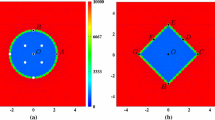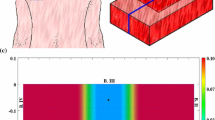Abstract
We develop a model of wound healing in the framework of finite elasticity, focussing our attention on the processes of growth and contraction in the dermal layer of the skin. The dermal tissue is treated as a hyperelastic cylinder that surrounds the wound and is subject to symmetric deformations. By considering the initial recoil that is observed upon the application of a circular wound, we estimate the degree of residual tension in the skin and build an evolution law for mechanosensitive growth of the dermal tissue. Contraction of the wound is governed by a phenomenological law in which radial pressure is prescribed at the wound edge. The model reproduces three main phases of the healing process. Initially, the wound recoils due to residual stress in the surrounding tissue; the wound then heals as a result of contraction and growth; and finally, healing slows as contraction and growth decrease. Over a longer time period, the surrounding tissue remodels, returning to the residually stressed state. We identify the steady state growth profile associated with this remodelled state. The model is then used to predict the outcome of rewounding experiments designed to quantify the amount of stress in the tissue, and also to simulate the application of pressure treatments.
















Similar content being viewed by others
Notes
We note that there is a one-to-one map between all states. Our convention is generally to view all spatially dependent variables as functions of the independent variable \(R_0\). So, for example, we write \(T_{rr}(R)\) as \(T_{rr}(R_0)=T_{rr}(R(R_0))\).
Numerically, we define steady state to be such that each \(\frac{\partial \gamma _i}{\partial t}\) is below a positive threshold value close to zero. For the simulations in Fig. 14, the threshold was taken to be \(10^{-5}\).
To test this, we ran simulations where the axial deformation was not fixed according to \(\lambda (t)=\lambda (T)\), but instead satisfied the spring condition in Eq. (29j). In this case, the sensitivity of the remodelling time to the axial growth parameter was significantly lower than that presented in Fig. 14.
References
Alford P, Humphrey J, Taber L (2008) Growth and remodeling in a thick-walled artery model: effects of spatial variations in wall constituents. Biomech Model Mechanobiol 7(4):245–62
Ambrosi D, Mollica F (2004) The role of stress in the growth of a multicell spheroid. J Math Biol 48(5):477–99
Annaidh A, Bruyère K, Destrade M, Gilchrist M, Maurini C, Otténio M, Saccomandi G (2012) Automated estimation of collagen fibre dispersion in the dermis and its contribution to the anisotropic behaviour of skin. Ann Biomed Eng 40(8):1666–78
Anzarut A, Olson J, Singh P, Rowe B, Tredget E (2009) The effectiveness of pressure garment therapy for the prevention of abnormal scarring after burn injury: a meta-analysis. J Plast Reconstr Aes 62(1):77–84
Bermudez D, Herdrich B, Xu J, Lind R, Beason D, Mitchell M, Soslowsky L, Liechty K (2011) Impaired biomechanical properties of diabetic skin implications in pathogenesis of diabetic wound complications. Am J Pathol 178(5):2215–23
Bowden L, Maini P, Moulton D, Tang J, Wang X, Liu P, Byrne H (2014) An ordinary differential equation model for full thickness wounds and the effects of diabetes. J Theor Biol 361:87–100
Chipev C, Simon M (2002) Phenotypic differences between dermal fibroblasts from different body sites determine their responses to tension and tgf\(\beta \)1. BMC Dermatol 2(1):13
Chung CY, Funamoto S, Firtel R (2001) Signaling pathways controlling cell polarity and chemotaxis. Trends Biochem Sci 26(9):557–566
Ciarletta P, Ben Amar M (2012) Papillary networks in the dermal-epidermal junction of skin: a biomechanical model. Mech Res Commun 42:68–76
Ciarletta P, Foret L, Ben Amar M (2011) The radial growth phase of malignant melanoma: multi-phase modelling, numerical simulations and linear stability analysis. J R Soc Interface 8(56):345–368
Clark R (1988) The molecular and cellular biology of wound repair. Plenum, New York
Cumming B, McElwain D, Upton Z (2010) A mathematical model of wound healing and subsequent scarring. J R Soc Interface 7(42):19–34
Dallon J (2000) Biological implications of a discrete mathematical model for collagen deposition and alignment in dermal wound repair. Math Med Biol 17(4):379–393
Dallon J, Sherratt J, Maini P (1999) Mathematical modelling of extracellular matrix dynamics using discrete cells: fiber orientation and tissue regeneration. J Theor Biol 199(4):449–71
Davidson L, Ezin A, Keller R (2002) Embryonic wound healing by apical contraction and ingression in xenopus laevis. Cell Motil Cytoskelet 53(3):163–176
Diridollou S, Patat F, Gens F, Vaillant L, Black D, Lagarde J, Gall Y, Berson M (2000) In vivo model of the mechanical properties of the human skin under suction. Skin Res Technol 6(4):214–221
Ehrlich H (1988) Wound closure: evidence of cooperation between fibroblasts and collagen matrix. Eye 2(2):149–157
Ehrlich H, Rajaratnam J (1990) Cell locomotion forces versus cell contraction forces for collagen lattice contraction: an in vitro model of wound contraction. Tissue Cell 22(4):407–417
Eringen A (1962) Nonlinear theory of continuous media. McGraw-Hill, New York
Flynn C, Taberner A, Nielsen P (2011) Modeling the mechanical response of in vivo human skin under a rich set of deformations. Ann Biomed Eng 39(7):1935–46
Ghosh K, Pan Z, Guan E, Ge S, Liu Y, Nakamura T, Ren X, Rafailovich M, Clark RAF (2007) Cell adaptation to a physiologically relevant ECM mimic with different viscoelastic properties. Biomaterials 28(4):671–679
Giele H, Liddiard K, Currie K, Wood F (1997) Direct measurement of cutaneous pressures generated by pressure garments. Burns 23(2):137–141
Goriely A, Vandiver R (2010) On the mechanical stability of growing arteries. IMA J Appl Math 75(4):549–570
Goriely A, Moulton D, Vandiver R (2010) Elastic cavitation, tube hollowing, and differential growth in plants and biological tissues. Europhys Lett 91(1):18,001
Grinnell F, Zhu M, Carlson MA, Abrams JM (1999) Release of mechanical tension triggers apoptosis of human fibroblasts in a model of regressing granulation tissue. Exp Cell Res 248(2):608–619
Gross J, Farinelli W, Sadow P, Anderson R, Bruns R (1995) On the mechanism of skin wound “contraction”: a granulation tissue “knockout” with a normal phenotype. P Natl A Sci USA 92(13):5982–5986
Hex N, Bartlett C, Wright D, Taylor M, Varley D (2012) Estimating the current and future costs of type 1 and type 2 diabetes in the UK, including direct health costs and indirect societal and productivity costs. Diabetic Med 29(7):855–62
Huang C, Leavitt T, Bayer L, Orgill D (2014) Effect of negative pressure wound therapy on wound healing. Curr Prob Surg 51(7):301–31
Jacquet E, Josse G, Khatyr F, Garcin C (2008) A new experimental method for measuring skin’s natural tension. Skin Res Technol 14(1):1–7
Jeffcoate W, Price P, Harding K (2004) Wound healing and treatments for people with diabetic foot ulcers. Diabetes Metab Res 20(Suppl 1):S78–89
Kessler D, Dethlefsen S, Haase I, Plomann M, Hirche F, Krieg T, Eckes B (2001) Fibroblasts in mechanically stressed collagen lattices assume a synthetic phenotype. J Biol Chem 276(39):36,575–36,585
Kischer C (1975) Alteration of hypertrophic scars induced by mechanical pressure. Arch Dermatol 111(1):60
Lin I, Taber L (1995) A model for stress-induced growth in the developing heart. J Biomech Eng 117(3):343
Maggelakis S (2004) Modelling the role of angiogenesis in epidermal wound healing. Discrete Contin Syst 4:267–273
Martin P (1997) Wound healing: aiming for perfect skin regeneration. Science 276(5309):75–81
Martin P, Lewis J (1992) Actin cables and epidermal movement in embryonic wound healing. Nature 360(6400):179–83
McDougall S, Dallon J, Sherratt J, Maini P (2006) Fibroblast migration and collagen deposition during dermal wound healing: mathematical modelling and clinical implications. Philos T Roy Soc A 364(1843):1385–405
McGrath M, Simon R (1983) Wound geometry and the kinetics of wound contraction. Plast Reconstr Surg 72(1):66–72
Mendez-Eastman S (2001) Guidelines for using negative pressure wound therapy. Adv Skin Wound Care 14(6):314–323
Monaco J, Lawrence W (2003) Acute wound healing an overview. Clin Plast Surg 30(1):1–12
Moulton D, Goriely A (2011) Possible role of differential growth in airway wall remodeling in asthma. J Appl Physiol 110(4):1003–12
North J, Gibson F (1978) Volume compressibility of human abdominal skin. J Biomech 11(4):203–207
Olsen L, Maini P, Sherratt J, Dallon J (1999) Mathematical modelling of anisotropy in fibrous connective tissue. Math Biosci 158(2):145–170
Pierce G, Mustoe T, Lingelbach J, Masakowski V, Griffin G, Senior R, Deuel T (1989) Platelet-derived growth factor and transforming growth factor-beta enhance tissue repair activities by unique mechanisms. J Cell Biol 109(1):429–440
Press W, Vetterling W, Teukolsky S, Flannery B, Greenwell Yanik E (1994) Numerical recipes in fortran-the art of scientific computing. SIAM Rev 36(1):149–149
Rachev A, Stergiopulos N, Meister J (1998) A model for geometric and mechanical adaptation of arteries to sustained hypertension. J Biomech Eng 120(1):9
Rivlin R (1948a) Large elastic deformations of isotropic materials I. Philos T Roy Soc A 240(822):459–490
Rivlin R (1948b) Large elastic deformations of isotropic materials III. Philos T Roy Soc A 240(823):509–525
Rodriguez E, Hoger A, McCulloch A (1994) Stress-dependent finite growth in soft elastic tissues. J Biomech 27(4):455–467
Segal R, Diegelmann R, Ward K, Reynolds A (2012) A differential equation model of collagen accumulation in a healing wound. B Math Biol 74(9):2165–82
Sherratt J, Murray J (1990) Models of epidermal wound healing. P Biol Sci 241(1300):29–36
Sherratt J, Murray J (1991) Mathematical analysis of a basic model for epidermal wound healing. J Math Biol 29:389–404
Sherratt J, Murray J (1992) Epidermal wound healing: the clinical implications of a simple mathematical model. Cell Transpl 1(5):365–371
Singer A, Clark R (1999) Cutaneous wound healing. N Eng J Med 341:738–746
Taber L (1998) A model for aortic growth based on fluid shear and fiber stresses. J Biomech Eng 120(3):348
Taber L (2001) Biomechanics of cardiovascular development. Annu Rev Biomed Eng 3:1–25
Taber L (2009) Towards a unified theory for morphomechanics. Philos T R Soc A 367(1902):3555–83
Taber L, Eggers D (1996) Theoretical study of stress-modulated growth in the aorta. J Theor Biol 180(4):343–57
Tracqui P, Woodward D, Cruywagen G, Cook J, Murray J (1995) A mechanical model for fibroblast-driven wound healing. J Biol Syst 3(4):1075–1084
Tranquillo R, Murray J (1992) Continuum model of fibroblast-driven wound contraction: Inflammation-mediation. J Theor Biol 158(2):135–172
Uhal B, Ramos C, Joshi I, Bifero A, Pardo A, Selman M (1998) Cell size, cell cycle, and alpha -smooth muscle actin expression by primary human lung fibroblasts. Am J Physiol Lung Cell Mol Physiol 275(5):998–1005
Vermolen F, Javierre E (2012) A finite-element model for healing of cutaneous wounds combining contraction, angiogenesis and closure. J Math Biol 65(5):967–96
Wahl S, Wong H, McCartney-Francis N (1989) Role of growth factors in inflammation and repair. J Cell Bioch 40(2):193–9
Wrobel L, Fray T, Molloy J, Adams J, Armitage M, Sparrow J (2002) Contractility of single human dermal myofibroblasts and fibroblasts. Cell Motil Cytoskelet 52(2):82–90
Wu M, Ben Amar M (2015) Growth and remodelling for profound circular wounds in skin. Biomech Model Mechanobiol 14(2):357–370
Wyczalkowski M, Varner V, Taber L (2013) Computational and experimental study of the mechanics of embryonic wound healing. J Mech Behav Biomed 28:125–146
Yang L, Witten T, Pidaparti R (2013) A biomechanical model of wound contraction and scar formation. J Theor Biol 332(null):228–248
Acknowledgments
LGB gratefully acknowledges the UK’s Engineering and Physical Sciences Research Council for funding through a studentship at the Systems Biology programme of the University of Oxford’s Doctoral Training Centre. The authors thank Dr. P.Y. Liu and Dr. X.T. Wang (Department of Plastic Surgery, Alpert Medical School of Brown University) for valuable discussions.
Conflict of interest
The authors declare that they have no conflict of interest.
Author information
Authors and Affiliations
Corresponding author
Rights and permissions
About this article
Cite this article
Bowden, L.G., Byrne, H.M., Maini, P.K. et al. A morphoelastic model for dermal wound closure. Biomech Model Mechanobiol 15, 663–681 (2016). https://doi.org/10.1007/s10237-015-0716-7
Received:
Accepted:
Published:
Issue Date:
DOI: https://doi.org/10.1007/s10237-015-0716-7




